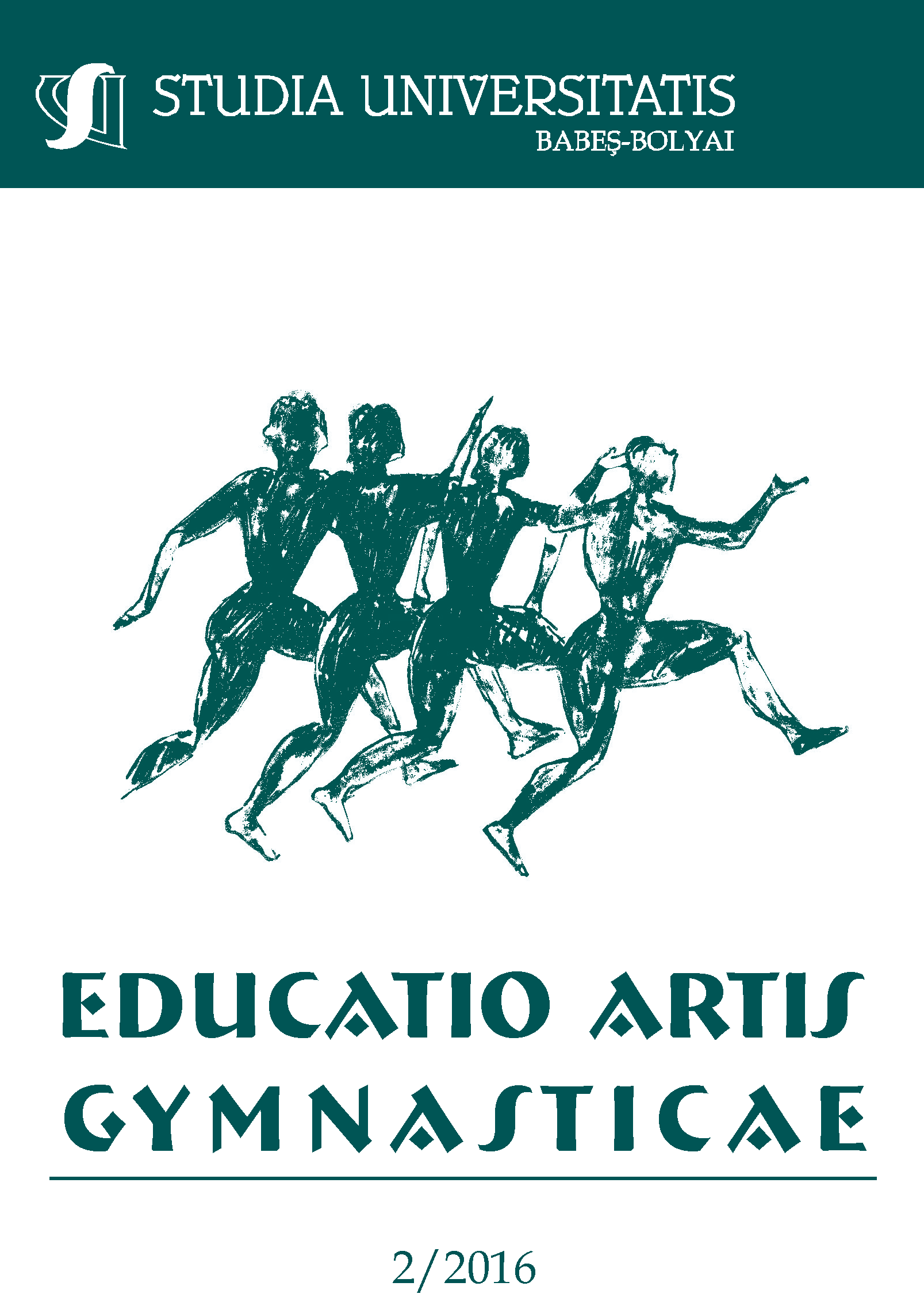WEIGHT TRAINING IN GYMS OF CLUJ-NAPOCA AS LEISURE PHYSICAL ACTIVITY: WARM-UP AND COOL-DOWN PHASES
Keywords:
warm-up, cool-down, fitness, weight training, leisure, Cluj-Napoca.Abstract
The human body becomes more efficient as it reaches adequate levels of physical fitness. Practicing regular exercise combined with good nutrition decreases the time needed for recovery and reconstruction of all tissues (Bushman, Clark-Young, & American College of Sports Medicine, 2005). The type of activities that people practice lifelong determines their functional capacity that they will keep for their own musculoskeletal system, with important implications for the whole body. The practice of weight training plays an important role in delaying and reducing the negative effects that aging has on the human body (American College of Sports Medicine, 2013). Objective of the study: The objective of this study was to investigate the weight training practiced as a leisure activity in Cluj-Napoca's fitness gyms. We were interested in methodical approach implemented by practitioners for warm-up and cool-down. Methods: The research was conducted from 14 August 2013 to 20 August 2014 in Cluj-Napoca's weight training gyms. The subjects were practitioners of all gyms where weight training is practised, and where we were granted access. We registered between 4 and 6 practitioners in every gym. A total of 155 practitioners were interviewed, 81 of them accepted to participate to our study. Conclusions: The methodical approach of weight training workouts is faulty for many practitioners. For most of them, the warm-up phase does not present proper importance and the majority of practitioners do not do it right. The situation is even worse if we analyse the implementation of cool-down phase. This part of workout is missing to almost all practitioners. Practitioners of weight training does not relate to dynamics of heart rate when they plan the warm-up and the cool-down for their workout. The heart rate dynamics recorded for weight training workouts were on a wide range of values. Practitioners presented different approaches and the lack of research it is a demand for all of us to continue the research in this field.
Antrenamentul cu greutăți în sălile de fitness din Cluj-Napoca ca activitate fizică de timp liber: aspecte privind pregătirea organismului pentru efort și liniștirea acestuia la sfârșitul ședinței de antrenament. Obiectivul studiului: Obiectivul acestui studiu a fost investigarea ședinței de antrenament specific acestei activități de timp liber din perspectiva începutului și sfârșitului antrenamentului. Ne-a interesat abordarea metodică pe care practicanții din sălile de fitness din Cluj-Napoca o realizează când încep și când termină antrenamentul cu greutăți. Subiecți și metode: Cercetarea s-a desfășurat pe perioada unui an, din data de 14 august 2013 până în data de 20 august 2014, în sălile de fitness din Cluj-Napoca. Subiecţii studiului sunt practicanți din toate sălile de fitness în care se efectuează antrenamente cu greutăți și în care ne-a fost acordat accesul, între 4 și 6 practicanți din fiecare sală de fitness. Au fost intervievați 155 de practicanți. 47,74% au refuzat participarea la studiu, iar 52,26% și-au dat acceptul. Concluzii. Din punct de vedere metodic mulți practicanți abordează deficitar antrenamentele cu greutăți în sălile de fitness. Pentru mulți dintre ei pregătirea organismului pentru efort nu prezintă importanța cuvenită, iar la foarte mulți dintre practicanți aceasta este realizată necorespunzător. Problemele sunt și mai mari atunci când este nevoie de includerea părții de liniștire după efortul din partea fundamentală. Această parte de antrenament lipsește la un număr foarte mare de practicanți. Practicanții antrenamentului cu greutăți nu se raportează la dinamica FC atunci când își construiesc partea de pregătire a organismului pentru efort sau cea de liniștire după efortul din partea fundamentală. Dinamica FC în antrenamentele cu greutăți înregistrate variază pe o plajă foarte largă. Abordările practicanților au fost foarte variate, iar lipsa cercetărilor pe această direcție ne obligă să continuăm studiile pe această direcție de cercetare.
Cuvinte-cheie: pregătirea organismului pentru efort, liniștirea organismului după efort, fitness, antrenament cu greutăți, timp liber, Cluj-Napoca.
References
American College of Sports Medicine. (2005). ACSM's Guidelines for Exercise Testing and Prescription - Seventh Edition. USA: Lippincott Williams & Wilkins.
American College of Sports Medicine. (2009). ACSM's Guidelines for Exercise Testing and Prescription - Eighth Edition. USA: Lippincott Williams & Wilkins.
American College of Sports Medicine. (2013). Current Comment Fact Sheets. Retrieved 05 10, 2013, from acsm.org: http://acsm.org/access-public-information/brochures-fact-sheets/fact-sheets
Bompa, T. (2002). Periodizarea: teoria şi metodologia antrenamentului. Bucureşti: Ex Ponto.
Bushman, B., Clark-Young, J., & American College of Sports Medicine. (2005). Action Plan for Osteoporosis. USA: Human Kinetics Publishers.
Bushman, B., Clark-Young, J., & American College of Sports Medicine. (2005). Action Plan for Osteoporosis. Statele Unite ale Americii: Human Kinetics Publishers.
Delavier, F., & Gundill, M. (2011). The Strength Training Anatomy Workout. USA: Human Kinetics Publishers.
Plowman, S. A., & Smith, D. L. (2002). Exercise Physiology for Health, Fitness, and Performance - 2nd Edition. USA: Benjamin-Cummings Publishing Company.
Ratamess Jr., N. (2012). ACSM's Foundations of Strength Training and Conditioning. USA: Lippincott Williams & Wilkins.
Sbenghe, T. (2005). Kinesiologie - Ştiinţa mişcării. Bucureşti: Editura Medicală.
Thompson, P. D., Franklin, B. A., Balady, G. J., Blair, S. N., Corrado, D., & colab. (2007). Exercise and Acute Cardiovascular Events: Placing the Risks Into Perspective. Circulation, 115, 2358-2368. doi:10.1161/CIRCULATIONAHA.107.181485
Văidăhăzan, R.-C., Hanțiu, I., Pop, N. H., & Pătrașcu, A. (2015). Heart rate recording system for participants to weight training in Cluj-Napoca's fitness gyms (compatibilities between Android and Windows 7). Studia Universitatis Babeş-Bolyai, Educatio Artis Gymnasticae, 1, 29-40.
Weinberg, R. S., & Gould, D. (2006). Foundations of Sport and Exercise Psychology - 4th edition. USA: Human Kinetics Publishers.
Wilmore, J., & Costill, D. (1993). Training for sport and activity - 3rd edition. USA: Human Kinetics Publishers.
Downloads
Published
How to Cite
Issue
Section
License
Copyright (c) 2016 Studia Universitatis Babeș-Bolyai Educatio Artis Gymnasticae

This work is licensed under a Creative Commons Attribution-NonCommercial-NoDerivatives 4.0 International License.






